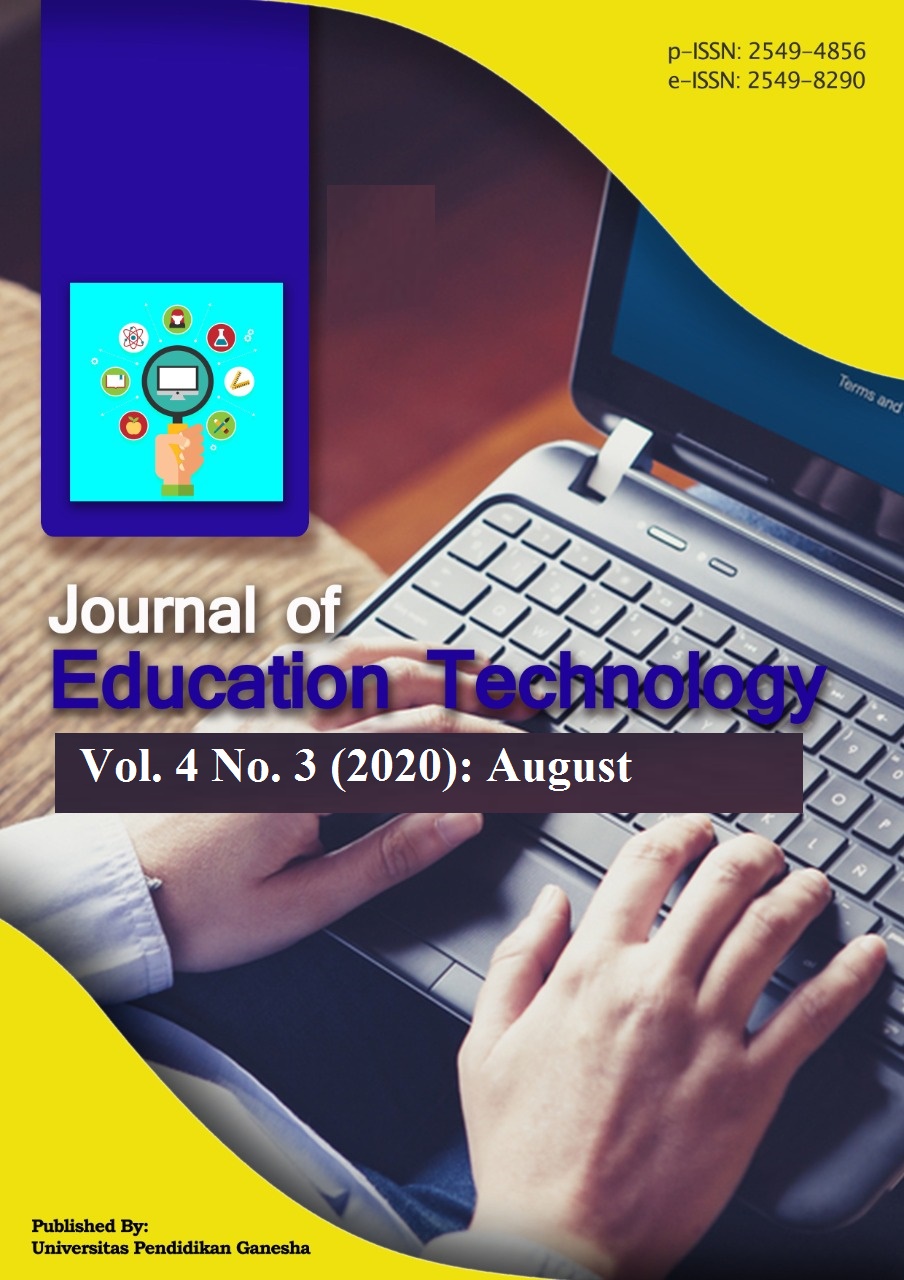The Use of Augmented Reality Cards to Improve Science Learning Outcomes About the Effect of Force on the Shape and Motion of Objects
DOI:
https://doi.org/10.23887/jet.v4i3.28528Abstract
The Science Learning of Kepanjen II Elementary School, Kecamatan Jombang, in the fourth grade on the effect of force on the shape and direction of motion of objects, experienced problems in the form of difficulty understanding the material by students. The results of the learning evaluation show that only 55% of the 30 students scored above the predetermined KKM of 75.0. Based on the problems that occur, the researchers plan to improve learning in 2 cycles. At the planning stage, it is carried out by analyzing KI and KD, making indicators, learning objectives, and continuing with compiling a lesson plan implementation and developing learning assessment instruments. Finally, in the planning stage, it is to create learning media, the Augmented reality application. At the implementation stage of learning has increased both teacher activities and student activities. Overall, the increase in teacher activity increased from 70% to 80%. Meanwhile, student activity increased from 72% to 90%. Learning outcomes before using Augmented Reality card media classical completeness of 55%. The results of student learning in the first cycle of classical completeness of 63% and the second cycle has increased to 84%.
References
Aningsih, & Zahrani, M. (2019). Peningkatan Pemahaman Konsep Siswa Pada Mata Pelajaran IPA Melalui Penerapan Model Contextual Teaching and Learning (CTL). Jurnal Pedagogik, 7(1), 48–56. https://doi.org/10.36768/Pedagogik.v2i1.28
Asmoro, B. P., & Mukti, F. D. (2019). Peningkatan Rasa Ingin Tahu Ilmu Pengetahuan Alam Melalui Model Contextual Teaching and Learning Pada Siswa Kelas Va Sekolah Dasar Negeri Karangroto 02. Abdau: Jurnal Pendidikan Madrasah Ibtidaiyah, 2(1), 115–142. https://doi.org/10.36768/abdau.v2i1.28
Bujuri, D. A. (2018). Analisis Perkembangan Kognitif Anak Usia Dasar dan Implikasinya dalam Kegiatan Belajar Mengajar. LITERASI (Jurnal Ilmu Pendidikan), 9(1), 37. https://doi.org/10.21927/literasi.2018.9(1).37-50
Dwi Mukti, F. (2019). Pengembangan Media Pembelajaran Augmented Reality (AR) di Kelas V MI Wahid Hasyim. Islamic Elementary Teacher Journal, 7(2), 48–60. https://doi.org/dx.doi.org/10.21043/elementary.v7i2.6351
Elyana. (2017). Penerapan Pendekatan Keterampilan Proses Untuk Meningkatkan Aktivitas dan Hasil Belajar Siswa Pada Mata Pelajaran IPA Kelas IV di SD Negeri 18 Rejang Lebong nasional untuk menciptakan manusia yang berilmu , bertaqwa dan berbudaya manusia . Jadi , pendidik. Jurnal Pendidikan Dasar, 1(2), 108–122. https://doi.org/10.36768/abdau.v2i1.277
Fakhrurrazi, F. (2018). Hakikat Pembelajaran Yang Efektif. At-Tafkir, 11(1), 85. https://doi.org/10.32505/at.v11i1.529
Fitriyati, I., Hidayat, A., & Munzil. (2017). Pengembangan Perangkat Pembelajaran IPA untuk Meningkatkan Kemampuan Berpikir Tingkat Tinggi dan Penalaran Ilmiah Siswa Sekolah Menengah Pertama. Jurnal Pembelajaran Sains, 1(1), 27–34.
Juwantara, R. A. (2019). Analisis Teori Perkembangan Kognitif Piaget pada Tahap Anak Usia Operasional Konkret 7-12 Tahun dalam Pembelajaran Matematika. Al-Adzka: Jurnal Ilmiah Pendidikan Guru Madrasah Ibtidaiyah, 9(1), 27. https://doi.org/10.18592/aladzkapgmi.v9i1.3011
Karlina, H. (2017). Penggunaan Media Audio-Visual Untuk Meningkatkan Kemampuan Menulis Naskah Drama. 1(April).
Mardiana, M. (2018). Penerapan Pembelajaran Ipa Berbasis Konstruktivisme Dalam Meningkatkan Sikap Ilmiah Pada Siswa Madrasah Ibtidayah. Al-Madrasah: Jurnal Pendidikan Madrasah Ibtidaiyah, 3(1), 61–80. https://doi.org/10.35931/am.v0i0.69
Oktiani, I. (2017). Kreativitas Guru dalam Meningkatkan Motivasi Belajar Peserta Didik. Jurnal Kependidikan, 5(2), 216–232. https://doi.org/10.24090/jk.v5i2.1939
Permana, M. S., & Johar, D. (2014). Pengembangan Media Pembelajaran Interaktif Ilmu Pengetahuan Alam (IPA) Berbasis Multimedia. Jurnal Algoritma Sekolah Tinggi Teknologi Garut Jadi, 11(2), 254–263. https://doi.org/ISSN : 2302-7339
Pindo, H., & Rinci, S. (2018). SEJ (School Education Journal) Vol. 8. No 2 Juni 2018. Meningkatkan Hasil Belajar Siswa Dengan Alat Peraga Pada Mata Pelajaran Ipa Kelas Iv Sdn Nomor 14 Simbolon Purba, 8(2), 112.
Prita, H., & Joko, T. (2017). Augment Reality sebagai Teknologi Interaktif dalam Pengenalan Benda Cagar Budaya Kepada Masyarakat. Jurnal Simetris, 8(2), 807–812. https://doi.org/DOI: 10.24176/simet.v8i2.1614Augment Reality Sebagai Teknologi Interaktif dalam pengenalan Benda Cagar Budaya Kepada Masyarakat
Riyanti, A., & Setyami, I. (2017). Penggunaan Media Pembelajaran Sastra. Jurnal Retorika, 10(2), 106–111. https://doi.org/10.26858/retorika.v
Setyawan, B. (2019). Augmented Reality Dalam. 07(01), 78–90.
Suandito, B. (2017). Bukti Informal Dalam Pembelajaran Matematika. Al-Jabar : Jurnal Pendidikan Matematika, 8(1), 13. https://doi.org/10.24042/ajpm.v8i1.1160
Suwardi, I., & Farnisa, R. (2018). Hubungan Peran Guru Dalam Proses Pembelajaran Terhadap Prestasi Belajar Siswa. Jurnal Gentala Pendidikan Dasar, 3(2), 181–202. https://doi.org/10.22437/gentala.v3i2.6758
Yuliono, T., Sarwanto, & Rintayati, P. (2019). Keefektifan Media Pemelajaran Augmented Reality Terhadap Penguasaan Konsep Sistem Pencernaan Manusia. JPD: Jurnal Pendidikan Dasar, 4(7), 65–84. https://doi.org/doi.org/10.21009/JPD.091.06 Keefektifan
Downloads
Published
How to Cite
Issue
Section
License
Authors who publish with the Journal of Education Technology agree to the following terms:
- Authors retain copyright and grant the journal the right of first publication with the work simultaneously licensed under a Creative Commons Attribution License (CC BY-SA 4.0) that allows others to share the work with an acknowledgment of the work's authorship and initial publication in this journal.
- Authors are able to enter into separate, additional contractual arrangements for the non-exclusive distribution of the journal's published version of the work (e.g., post it to an institutional repository or publish it in a book), with an acknowledgment of its initial publication in this journal.
- Authors are permitted and encouraged to post their work online (e.g., in institutional repositories or on their website) prior to and during the submission process, as it can lead to productive exchanges, as well as earlier and greater citation of published work. (See The Effect of Open Access)
















